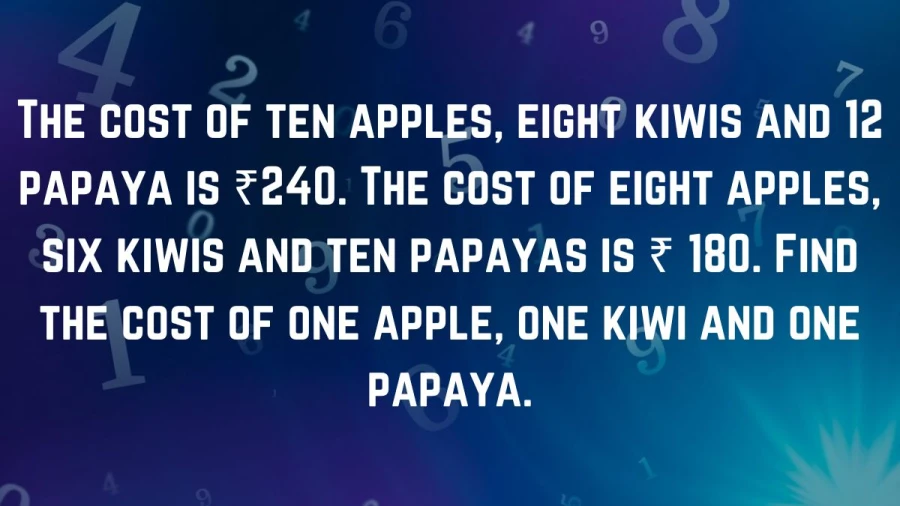If you happen to be viewing the article The cost of ten apples, eight kiwis and 12 papaya is ₹240. The cost of eight apples, six kiwis and ten papayas is ₹ 180. Find the cost of one apple, one kiwi and one papaya. ? on the website Math Hello Kitty, there are a couple of convenient ways for you to navigate through the content. You have the option to simply scroll down and leisurely read each section at your own pace. Alternatively, if you’re in a rush or looking for specific information, you can swiftly click on the table of contents provided. This will instantly direct you to the exact section that contains the information you need most urgently.
Crack the fruit math problem: Unravel the mystery of fruit prices with two equations. Find out how much one apple, one kiwi, and one papaya cost.
The cost of ten apples, eight kiwis and 12 papaya is ₹240. The cost of eight apples, six kiwis and ten papayas is ₹ 180. Find the cost of one apple, one kiwi and one papaya.
Let’s denote the cost of an apple, a kiwi, and a papaya as A, K, and P respectively.
We are given a system of two equations with three unknowns:
- 10A + 8K + 12P = 240 (Equation 1)
- 8A + 6K + 10P = 180 (Equation 2)
To solve for the cost of one apple, one kiwi, and one papaya (A + K + P), we need to eliminate one of the variables. Since we have two equations and three unknowns, eliminating one variable is possible.
Article continues below advertisement
Here, we can eliminate P by subtracting Equation 2 from Equation 1:
(1) 10A + 8K + 12P = 240
(-) (2) 8A + 6K + 10P = 180
2A + 2K + 2P = 60
Dividing both sides by 2, we get:
A + K + P = 30
Therefore, the cost of one apple, one kiwi, and one papaya is ₹30.
Systems of Linear Equations
A system of linear equations is a collection of two or more linear equations, which involve the same variables. A linear equation is an equation where the highest power of each variable is 1.
Article continues below advertisement
Article continues below advertisement
Here are some key points about systems of linear equations:
- Variables: Each equation in the system involves the same set of variables. These variables represent unknown quantities that we want to solve for.
- Solution: A solution of a system of linear equations is a set of values for the variables that satisfies all the equations in the system simultaneously. In other words, if you plug these values into each equation, you get a true statement.
- Number of solutions: Depending on the relationships between the equations, a system can have:
- One unique solution: This is the most common case, where the lines (for 2 variables) or planes (for 3 variables) representing the equations intersect at a single point.
- Infinitely many solutions: This occurs when the equations represent lines (or planes) that completely overlap, indicating any point on that line (or plane) satisfies both equations.
- No solution: This happens when the lines (or planes) are parallel, indicating they never intersect.
Example:
Here’s an example of a system of linear equations in two variables:
- Equation 1: 2x + 3y = 5
- Equation 2: x – y = 1
This system can be solved using various methods like:
- Graphical method: Plotting both equations and finding the point of intersection.
- Substitution method: Solving one equation for one variable and substituting it into the other equation to solve for the remaining variable.
- Elimination method: Manipulating the equations to eliminate one variable and then solving for the remaining variable.
These methods will help you find the solution, which in this case is:
Thank you so much for taking the time to read the article titled The cost of ten apples, eight kiwis and 12 papaya is ₹240. The cost of eight apples, six kiwis and ten papayas is ₹ 180. Find the cost of one apple, one kiwi and one papaya. written by Math Hello Kitty. Your support means a lot to us! We are glad that you found this article useful. If you have any feedback or thoughts, we would love to hear from you. Don’t forget to leave a comment and review on our website to help introduce it to others. Once again, we sincerely appreciate your support and thank you for being a valued reader!
Source: Math Hello Kitty
Categories: Math

